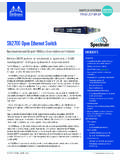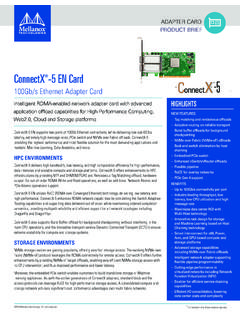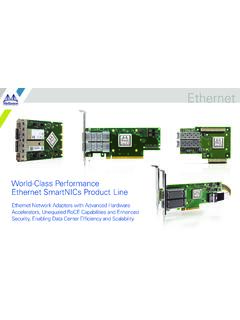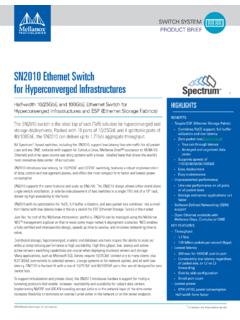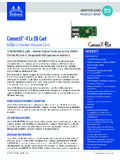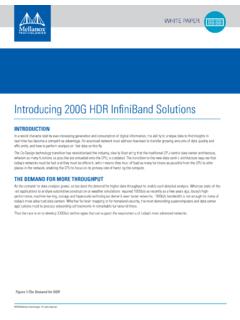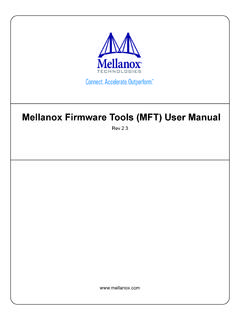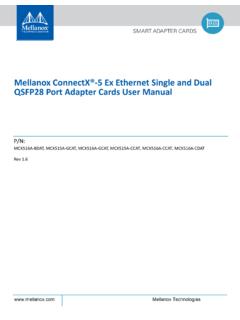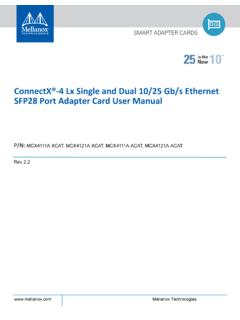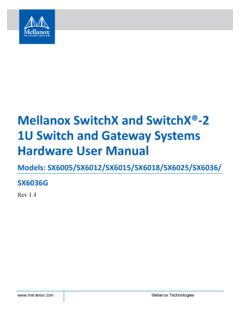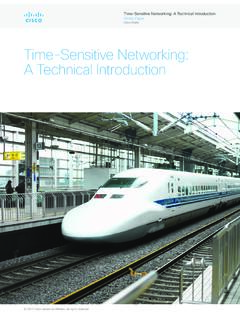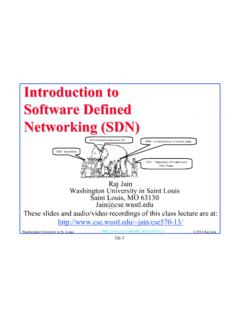Transcription of Introduction to InfiniBand - Mellanox Networking: End-to ...
1 Mellanox Technologies Inc. 2900 Stender Way, Santa Clara, CA 95054 Tel: 408-970-3400 Fax: 408-970-3403 1 White PaperDocument Number2003 WPMellanox Technologies IncRev to InfiniBand Executive SummaryInfiniBand is a powerful new architecture designed to support I/O connectivity for the Internet infrastructure. InfiniBand is supported by all the major OEM server vendors as a means to expand beyond and create the next generation I/O interconnect standard in servers. For the first time, a high volume, industry standard I/O interconnect extends the role of traditional in the box busses.
2 InfiniBand is unique in providing both, an in the box backplane solution, an external interconnect, and Bandwidth Out of the box , thus it provides connectivity in a way pre-viously reserved only for traditional networking interconnects. This unification of I/O and system area networking requires a new architecture that supports the needs of these two previously sepa-rate domains. Underlying this major I/O transition is InfiniBand s ability to support the Internet s requirement for RAS: reliability, availability, and serviceability. This white paper discusses the features and capabilities which demonstrate InfiniBand s superior abilities to support RAS relative to the leg-acy PCI bus and other proprietary switch fabric and I/O solutions.
3 Further, it provides an over-view of how the InfiniBand architecture supports a comprehensive silicon, software , and system solution. The comprehensive nature of the architecture is illustrated by providing an overview of the major sections of the InfiniBand specification. The scope of the specification ranges from industry standard electrical interfaces and mechanical connectors to well defined software and management interfaces. The paper is divided into four sections. The Introduction sets the stage for InfiniBand and illustrates why all the major server vendors have made the decision to embrace this new standard.
4 The next section reviews the effect Infini-Band will have on various markets that are currently being addressed by legacy technologies. The third section provides a comparison between switch fabrics and bus architecture in general and then delves into details comparing InfiniBand to PCI and other proprietary solutions. The final section goes into details about the architecture, reviewing at a high level the most important fea-tures of to InfiniBand 2 Mellanox Technologies IncRev IntroductionAmdahl s Law is one of the fundamental principles of computer science and basically states that efficient systems must provide a balance between CPU performance, memory bandwidth, and I/O performance.
5 At odds with this, is Moore s Law which has accurately predicted that semiconduc-tors double their performance roughly every 18 months. Since I/O interconnects are governed by mechanical and electrical limitations more severe than the scaling capabilities of semiconductors, these two laws lead to an eventual imbalance and limit system performance. This would suggest that I/O interconnects need to radically change every few years in order to maintain system per-formance. In fact, there is another practical law which prevents I/O interconnects from changing frequently - if it ain t broke don t fix architectures have a tremendous amount of inertia because they dictate the mechanical con-nections of computer systems and network interface cards as well as the bus interface architecture of semiconductor devices.
6 For this reason, successful bus architectures typically enjoy a dominant position for ten years or more. The PCI bus was introduced to the standard PC architecture in the early 90 s and has maintained its dominance with only one major upgrade during that period: from 32 bit/33 MHz to 64bit/66 Mhz. The PCI-X initiative takes this one step further to 133 MHz and seemingly should provide the PCI architecture with a few more years of life. But there is a divergence between what personal computers and servers require. Personal Computers or PCs are not pushing the bandwidth capabilities of PCI 64/66.
7 PCI slots offer a great way for home or business users to purchase networking , video decode, advanced sounds, or other cards and upgrade the capabilities of their PC. On the other hand, servers today often include clustering, networking (Gigabit Ethernet) and storage (Fibre Channel) cards in a sin-gle system and these push the 1GB bandwidth limit of PCI-X. With the deployment of the Infini-Band architecture, the bandwidth limitation of PCI-X becomes even more acute. The InfiniBand Architecture has defined 4X links, which are being deployed as PCI HCAs (Host Channel Adapt-ers) in the market today.
8 Even though these HCAs offer greater bandwidth that has ever been achieved in the past, PCI-X is a bottleneck as the total aggregate bandwidth of a single InfiniBand 4X link is 20 Gb/s or GB/s. This is where new local I/O technologies like HyperTransport and 3 GIO will play a key complementary role to InfiniBand . The popularity of the Internet and the demand for 24/7 uptime is driving system performance and reliability requirements to levels that today s PCI interconnect architectures can no longer sup-port. Data storage elements; web, application and database servers; and enterprise computing is driving the need for fail-safe, always available systems, offering ever higher performance.
9 The trend in the industry is to move storage out of the server to isolated storage networks and distrib-ute data across fault tolerant storage systems. These demands go beyond a simple requirement for more bandwidth, and PCI based systems have reached the limits of shared bus architectures. With CPU frequencies passing the gigahertz (Ghz) threshold and network bandwidth exceeding one gigabit per second (Gb/s), there is a need for a new I/O interconnect offering higher bandwidth to support and scale with today s InfiniBand , a switch-based serial I/O interconnect architecture operating at a base speed of Gb/s or 10 Gb/s in each direction (per port).
10 Unlike shared bus architectures, InfiniBand is a low pin count serial architecture that connects devices on the PCB and enables Bandwidth Out Introduction to InfiniBand Markets3 Mellanox Technologies IncRev the Box , spanning distances up to 17m over ordinary twisted pair copper wires. Over common fiber cable, it can span distances of several kilometers or more. Furthermore, InfiniBand provides both QoS (Quality of Service) and RAS. These RAS capabilities have been designed into the InfiniBand architecture from the beginning and are critical to its ability to serve as the common I/O infrastructure for the next generation of compute server and storage systems at the heart of the Internet.
